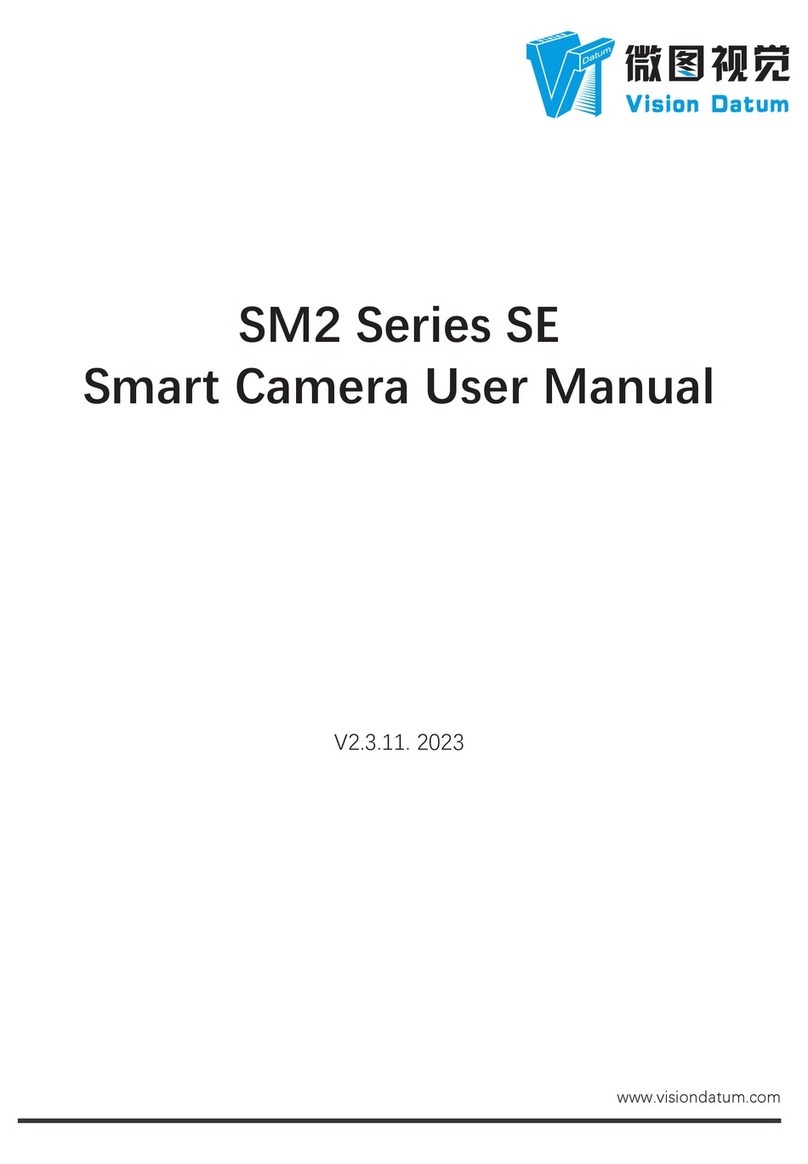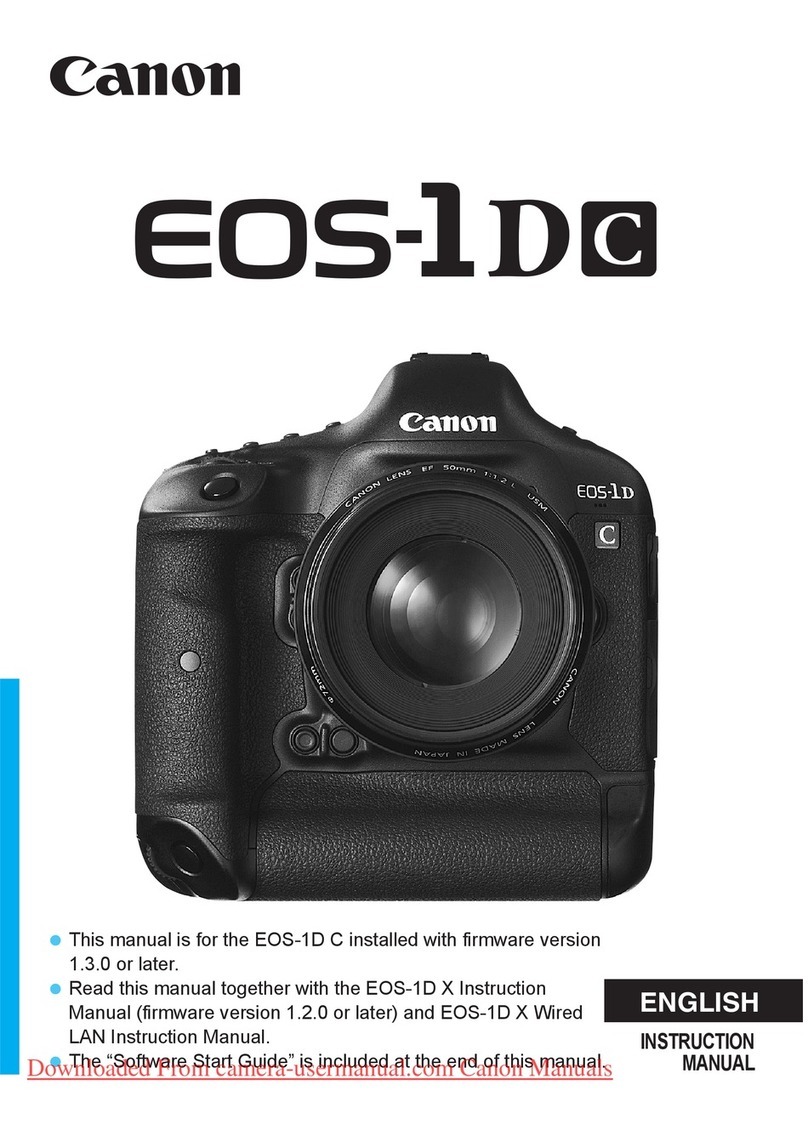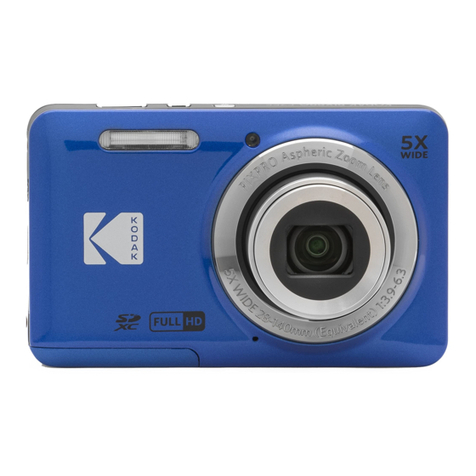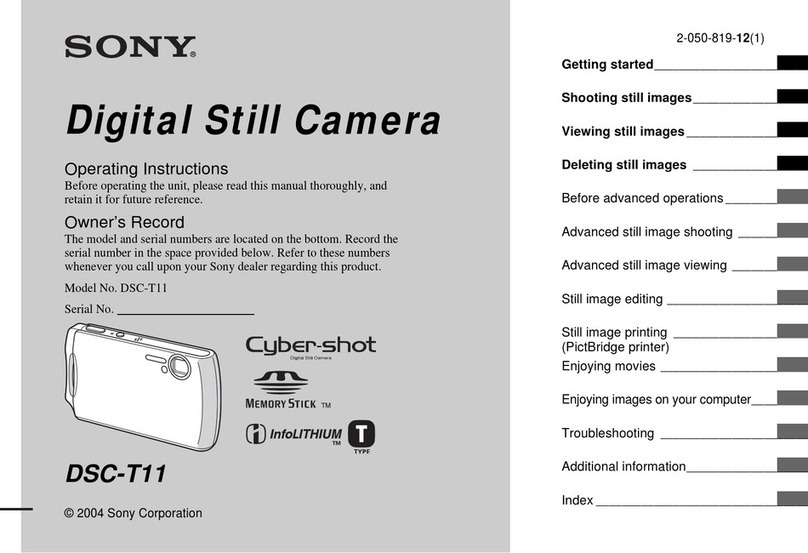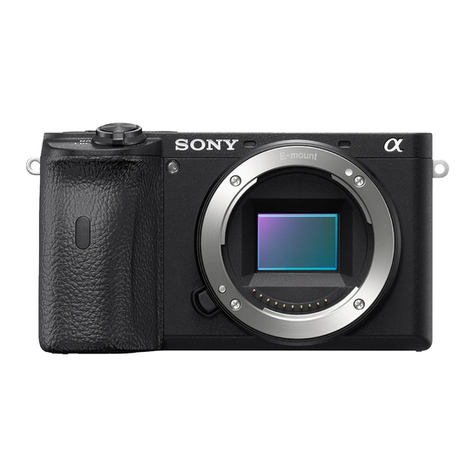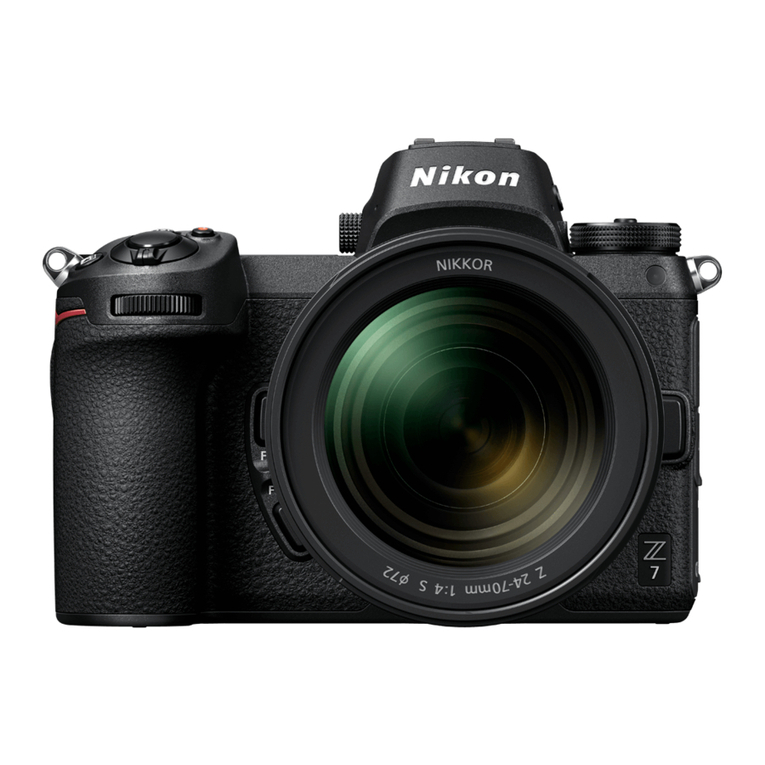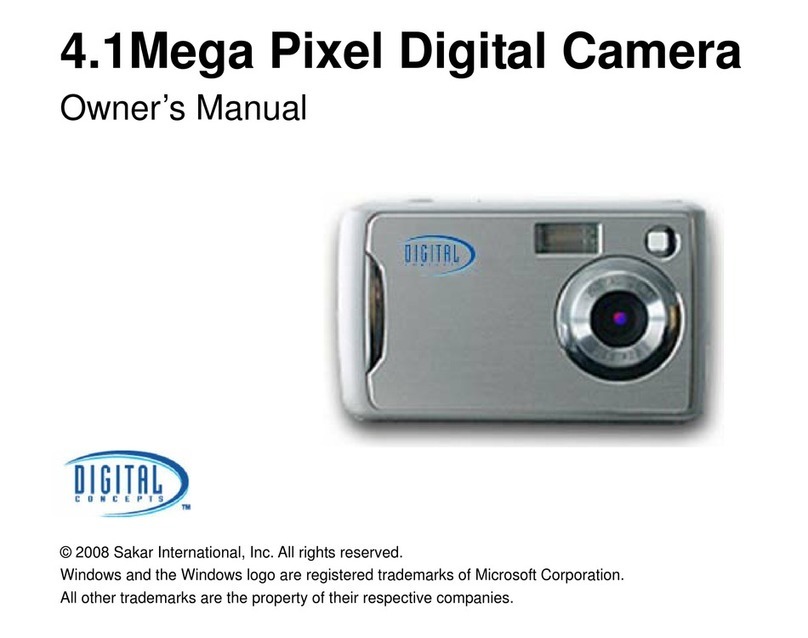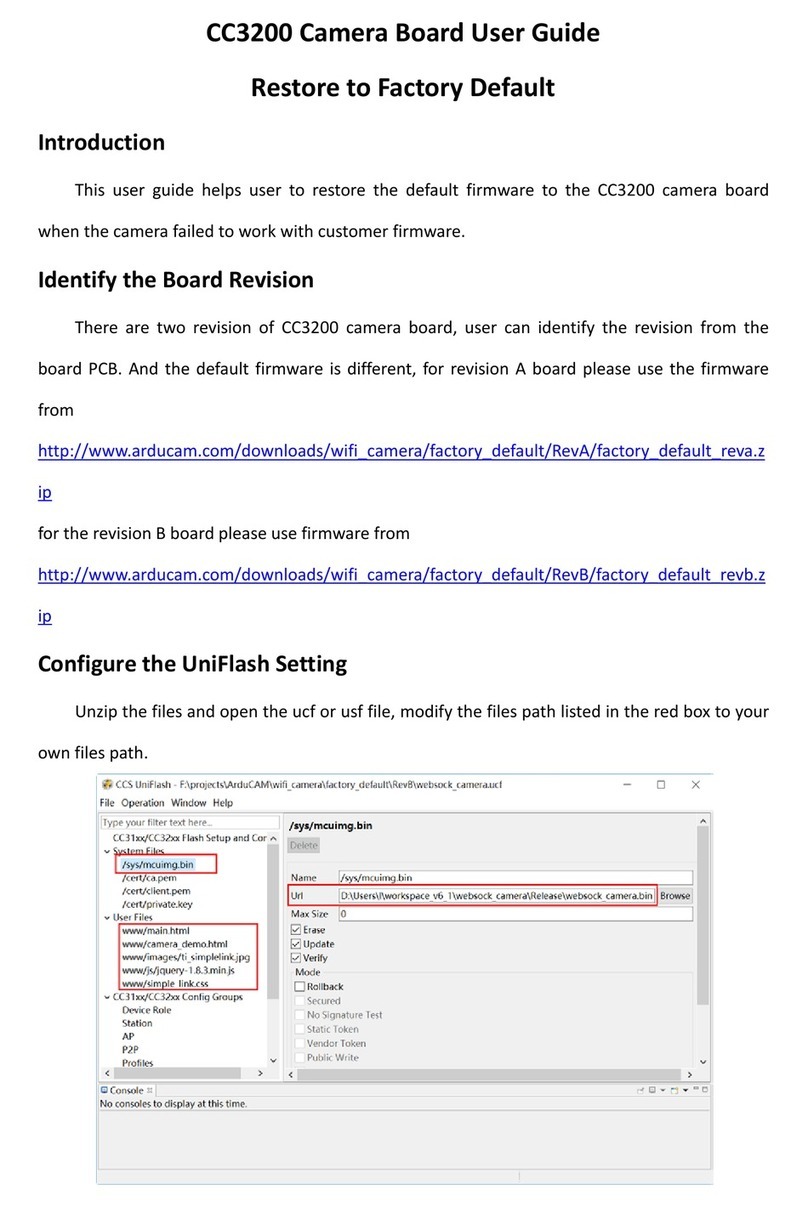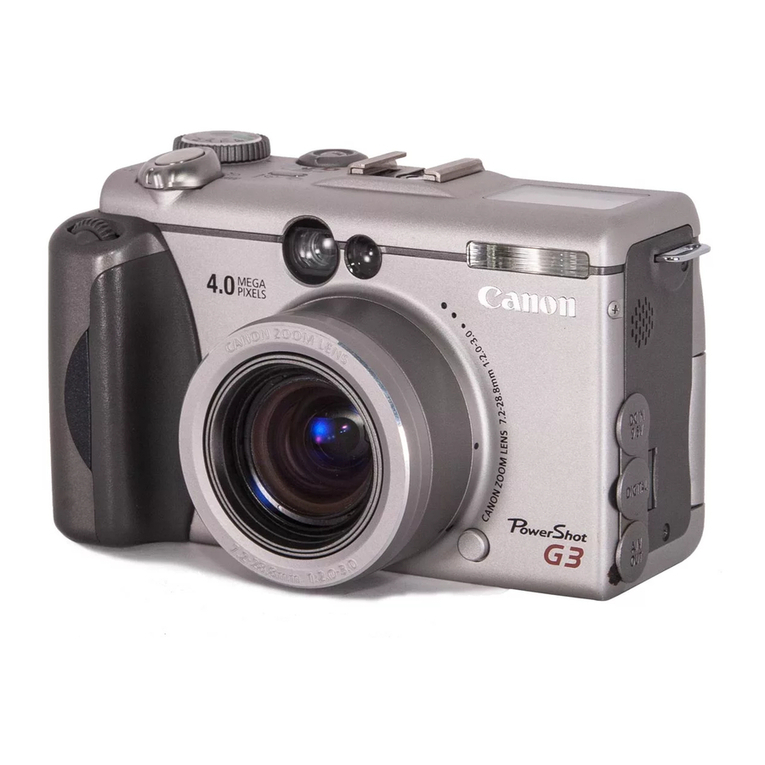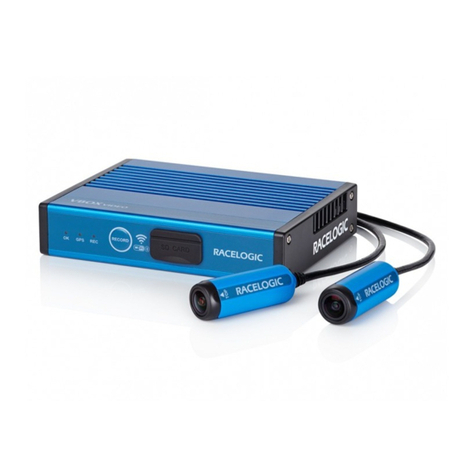Vision Datum LEO Series User manual

LEO Series
GigE Area Scan Camera
User Manual
www.visiondatum.com
V2.3.9, Sep. 2023

LEO GigE Area Scan User Manual 2
Copyright ©2023
Hangzhou Vision Datum Technology Co., Ltd.
Tel.: +86 571-86888309
Add.:No. 8 Xiyuan 9th Road, West Lake District Hangzhou Zhejiang 310030 China.
All rights reserved. The information contained herein is proprietary and is provided solely for the purpose of allowing customers to operate
and/or service Vision Datum manufactured equipment and is not to be released, reproduced, or used for any other purpose without written
permission of Vision Datum.
Disclaimer
The information and specifications described in this manual are subject to change without notice.
Latest Manual Version
For the latest version of this manual, see the Download Center on our web site at: http://www.visiondatum.com/en/service/005001.html
Technical Support
For technical support, e-mail:[email protected].
Warranty
To ensure that your warranty remains in force, adhere to the following guidelines:
Do not remove the camera’s serial number label
If the label is removed and the serial number can’t be read from the camera’s registers, the warranty is void.
Do not open the camera housing
Do not open the housing. Touching internal components may damage them.
Prevent ingress or insertion of foreign substances into the camera housing
Prevent liquid, flammable, or metallic substances from entering the camera housing. If operated with any foreign substances inside, the
camera may fail or cause a fire.
Avoid electromagnetic fields
Do not operate the camera in the vicinity of strong electromagnetic fields. Avoid electrostatic charging.
Clean with care
Avoid cleaning the sensor if possible.
Handle this camera with care
Do not abuse the camera. Avoid striking, shaking, etc. The camera could be damaged by improper handling.
Read the manual
Read the manual carefully before using the camera.
Preface
Preface
Purpose
This Manual is a basic description of LEO series GigE Area Scan Cameras, which mainly includes the product description, quick installation
guide and Simple introduction of SDK(iDatum). This manual may be updated due to product upgrades or other reasons. If you need, please
contact the sales engineer for the latest version of this manual.

LEO GigE Area Scan User Manual 3
1
Product
Description
1
CHAPTER 1 PRODUCT DESCRIPTION
Product Introduction
LEO series industrial cameras compatible with GigE、10GigE、USB3.0、Cameralink and CoaXPress data bus standards, support GenICam、
USB3 Vision® and GigE Vision®, Smoothly connect with third-party software, like HALCON and Vision Pro, not need for secondary
development. LEO series cameras with excellent cost performance and very suitable for various inspections measurement and high-speed
imaging applications. This series cameras won customers high praise because its outstanding performance in cellphone and tablet PC
screen inspection, LED automatic packaging, defect inspection, and electronic components manufacturing, wafer positioning and other
applications.
With this variety of sensors and interfaces, combined with the extensive features offered, LEO series cameras are fit for a wide range of
vision applications.
Product Features
■ Ethernet interface provides 1Gbps bandwidth, with maximum 100m transmission;
■ 128MB on-board frame buffer for data transmission and image retransmission;
■ Supports software trigger, hardware trigger, free run mode and etc;
■ Supports sharpness, noise reduction, gamma correction, LUT, black level correction, brightness,contrast and other ISP function;
■ Supports interpolation algorithm, white balance algorithm, color conversion matrix, hue,saturation and etc. for color camera;
■ Supports various output formats for image data and supports ROI, binning, mirror and etc.;
■ Conforms GigE Vision protocol and GenICam standards;
* The camera functions may differ by camera models,please refer to actual functions.
Status LED Description
Status LED Description
Slow Flashing Red
(the interval between on and off is 2000 milliseconds) The camera wiring exception occurs.
Red light is always on The camera exception occurs.
Blue light is always off The camera is in idle status.
Fast Flashing Blue
(the interval between on and off is 200 milliseconds) The camera is acquiring images normally.
Slow Flashing blue
(the interval between on and off is 1000 milliseconds)
The camera is acquiring images in trigger
mode.
Flashing Alternately Red and Blue The firmware is updating.

LEO GigE Area Scan User Manual 4
1
Product
Description
Mechanical Dimensions
The dimensions is in millimeters:
The cameras are interfaced to an external circuity via connectors located on the back of the housing.
The Industrial camera rear appearance contains standard RJ45 GigE interface, 6pin power, I/O input connector and camera working
status indicator light.
There are two M2 screw holes on both side of GigE interface, which used to fix cable to reduce the loosening caused by vibration.
Camera Housing and Base Mounting Hole Size(mm):
Fig. 1-1: Mechanical Dimensions (in mm) of the C-mount GigE Cameras with 29*29*42mm housing (The installation uses M2 and M3 screws).
Fig. 1-4: Mechanical Dimensions (in mm) of the C-mount GigE Cameras with 29 * 44 * 59 mm housing (The installation uses M2 and M3 screws).
29
29
20
23.7
22
4.5
4-M2x3
2-M2x3
20
3
12
42
3-M3x3
59
523 4-M3x3.5
29
44
26
20 2-M2x4
Fig. 1-2: Mechanical Dimensions (in mm) of the C-mount GigE Cameras with 29*29*42mm housing mounted on all sides(The installation uses M2 and M3
screws).
3
12
42
3-M3 2.5
29
29 20
23 .7
224.5
4-M2 2.5
2-M2 3
20 2-M 3 2.5
2.25
20
2-M3 x2.5
29
29
20
23 .7
37 .6
42
4-M3 3
20 42-M2
2.1 2.75
62.06
Fig. 1-3: Mechanical Dimensions (in mm) of the C-mount GigE Cameras with 29 * 29 * 42 mm housing (The installation uses M2 and M3 screws).

5LEO GigE Area Scan User Manual
1 1
Product
Description
Mechanical Dimensions
Fig. 1-5: Mechanical Dimensions (in mm) of the M58 GigE Cameras with 74 * 74 * 47.5 mm housing (Without fan,the installation uses M2 and M3 screws).
74
74
M58X0.75
60
4-M3x5
24.5
24.5 4-M3 x3
5
20
2-M2 x4
47
.
5
11.48 -0.15
+0.05
60
74
74
60
4-M3x5
60
24.5
24.5
5
4-M3x3
M58X0.75 OPTICALDISTANCE
11.48 -0.15
+0.05
75.3
47.5
20
2-M2x4
Fig. 1-6: Mechanical Dimensions (in mm) of the M58 Mount GigE Cameras with 74 * 74 * 75.3 mm housing (With fan,the installation uses M2 and M3 screws).
Fig. 1-7: Mechanical Dimensions (in mm) of the M58 Mount GigE Cameras with 74 * 74 * 72.7mm housing (With fan,the installation uses M2 and M3
screws).
74
74
60
4-M3 x5
60
24.5
24.5
4-M3 x3
M58X0.75
OPTICALDISTANCE
11.48 -0.15
+0.05
72.7
44.88
3.88
20
2-M2 x4

LEO GigE Area Scan User Manual 6
1
Product
Description
Fig. 1-10: Mechanical Dimensions (in mm) of the F-Mount GigE Cameras with 74 * 74 * 78.4mm housing (With fan,the installation uses M2 and M3
screws).
20
2-M2 x4
OPTICALDISTANCE
46.5 -0.15
+0.05
4-M3 x3
50.6
78.4
74
74
60
4-M3 x5
60
24.5
24.58.6
Fig. 1-9: Mechanical Dimensions (in mm) of the F-Mount GigE Cameras with 74 * 74 * 53.9mm housing (Without fan,the installation uses M2 and M3
screws).
20
2-M2x4
46.5 -0.15
+0.05
4-M3 x3
53.9
74
74
60
4-M3 x5
60
24.5
24.5
11.38
Mechanical Dimensions
Fig. 1-8: Mechanical Dimensions (in mm) of the M58 Mount GigE Cameras with 74 * 74 * 74.4mm housing (With fan,the installation uses M2 and M3
screws).
74
74
60
4-M3x5
60
24.5
24.5
5.6
4-M3x3
OPTICALDISTANCE
11.48 -0.15
+0.05 20
2-M2x4
46.6
74.4
M58*0.75

7LEO GigE Area Scan User Manual
1 1
Product
Description
Mechanical Dimensions
Fig. 1-11: Mechanical Dimensions (in mm) of the F-Mount GigE Cameras with 74 * 74 * 80.1mm housing (With fan,the installation uses M2 and M3
screws).
74
74
60
4-M3 x5
60
20
2-M2 x4
OPTICALDISTANCE
46.5 -0.15
+0.05
4-M3 x3
80.1
52.3
24.5
24.5
8.8

LEO GigE Area Scan User Manual 8
32
Power and
I/O Interface Definition
2
CHAPTER 2
POWER AND
I/O IENTERFACE DEFINITION
I/O Connection Definition and Assignments
There are 2 types of power and I/O interfaces, including 6-pin and 12-pin power and I/O interfaces. Read the followings to get
pin definitions.Refer to the pin definitions and labels attached to the power and I/O cable to wire the device.
Table 2-1:
Numbering and assignments for
6pin Power and I/O Input Connector:
1
2
34
5
6
78
9
1
2
3
4
5
6
11
10
12
Table 2-2:
Numbering and assignments for
12pin Power and I/O Input Connector:
Color Pin Signal Signal Source Designation
Red 1 DC_PWR - DC Camera Power
Green 2 OPTO_IN Line 0+ Opto-isolated IN
White 3 GPIO Line 2+ Can be configured as input or output
Blue 4OPTO_OUT Line 1+ Opto-isolated OUT
Brown 5OPTO_GND Line 0/1- Opto-isolated Signal Ground
Black 6 GND Line 2- Camera Power Supply Ground
Color Pin Signal Signal Source Designation
Black 1 GND Line 2- Camera Power Supply Ground
Red 2 DC_PWR - DC Camera Power
Brown 3 - - -
Orange 4 - - -
Yellow 5 GND_IO Line 0/1- Opto-isolated Signal Ground
Green 6 - - -
Blue 7 - - -
Purple 8 RS232_RX - RS232 Received Data
Gray 9 RS232_TX - RS232 Transmitted Data
White 10 GPIO Line 2+ Can be Configured as Input or Output
Pink 11 OPTO_OUT Line 1+ Opto-isolated OUT
Light green 12 OPTO_IN Line 0+ Opto-isolated IN
The wire color of this user manual is the color of Vision Datum. If you use other manufacturers' cable color definitions may be
different, random connection may cause the camera to burn out, please connect according to the I/O port type and pin definition
or contact our technical staff for advise.

9LEO GigE Area Scan User Manual
3 3
Installation
and Setup
2
Power and
I/O Interface Definition
3
CHAPTER 3 INSTALLATION AND SETUP
You should perform the software installation procedure first and the hardware installation procedure second.
Software Installation
iDatum Installation
System Requirements
LEO Camera Software Suite for Windows requirements that one of the following operating systems is installed on your computer:
■ Windows XP (32 bit)
■ Windows 7 (32 bit or 64 bit)
■ Windows 10 (32 bit or 64 bit)
■ Linux 32 Bit/64 Bit : Ubuntu 14.04(32/64)、Ubuntu 16.04(32/64)、 Redhat7(64)、Centos7(32/64)、gcc/g++ version requires 4.6.3
and above
■ ARM: NVIDIA TX2、RaspberryPiB3.0+
Installation Steps
1.You can download the iDatum software(LEO Series Industrial Cameras SDK For xxx)from:
http://www.visiondatum.com/en/service/005001.html
2.Double click iDatum installation package to install the client.
3.Follow the instructions on the screen. The installer will guide you through the installation process.
If you use a firewall on your computer, disable the firewall for the network adapter to which your camera is connected.
Close the Firewall
In order to ensure the camera software keep running and image transmission stability, please close the firewall before using
the software.
Environment Testing
After successful installation, please connect the camera and turn on iDatum client software to check the
result of camera connection and image preview. You can start secondary development base on the SDK
when all environment testing is normal.
You should notice follow items when using GigE Camera:
■ FrameRate Whether the frame rate is consistent with the actual set frame rate.
■ Errors If not 0, it means there is a frame skip, it is abnormal.
■ Lost Packets If not 0, it is abnormal.

LEO GigE Area Scan User Manual 10
3
Installation
and Setup
Hardware Installation
Camera Installation
The installation procedures assume that you will be making a peer-to-peer connection between your camera and a
computer.
Make sure that the following items are available before starting the installation:
■ LEO GigE Area scan camera
■ Applicable power supply or a Gigabit Ethernet Switch
■ It refers to the lens that matches with lens mount of the camera.
■ The computer with a GigE network adapter installed
■ The computer must be equipped with appropriate operating system
■ Standard Ethernet cable (CAT6 or above).
Steps:
■ Mount lens that matches with lens mount of the camera
■ Connect the camera to the computer and power
PoE:
● For the camera that supports PoE, use a network cable to connect the camera to a switch that supports PoE or a network
interface card.
Direct supply::
● Use the 6-pin or 12-pin power and I/O cable to connect the camera to a power adapter.
Network Settings
Before using the camera, you need to configure IP is in the same network segment with the computer. You can modify it in “Local
Connection” to ensure network communication is normal.
Local Network Configuration :
● Click “Control Panel”> “Network and Internet”> “Network and Sharing Center”> “Change Adapter Configuration. “Then
select corresponding network card to configure it automatically obtain IP address or manually assign it as same network
segment address with the camera. Shown as below:
● Open “Advanced” in the properties, set “Jumbo Frame” as its maximum value:9014bytes, both of transmit buffer and receive
buffer set as 2048bytes, the Interrupt Throttle Rate set as extremum value. These maximum values mentioned above depend on
the specific network card. Shown as below:

11 LEO GigE Area Scan User Manual
3 3
Installation
and Setup
Software Operation
iDatum Operation
1、Double-click the iDatum shortcut on the desktop to open up the client software.
Menu Bar
The menu bar for iDatum client provides following functions: File, View, Settings, Tool and Help, as shown in the figure below.
Control Toolbar
The control toolbar provides quick operations for the device. the icon meaning is shown in the figure below. The
operation buttons in the tool bar can quickly and conveniently edit camera images.
Main interface
For specific main window of the client software, please refer to the actual one you got.

LEO GigE Area Scan User Manual 12
3
Installation
and Setup
The camera’s attribute tree and parameters may differ by camera models.
i
Software Operation
■ Connection/Disconnection:After you selecting the camera, click “Connect” to connect the camera; click “Disconnect “to disconnect
the camera.
■ Start/Stop Acquisition:For current connected camera,click “Start Acquisition “to acquire image data; click “Stop Acquisition “to
stop image data acquisition.
■ Batch Start Acquisition:click “Batch Start Acquisition “to start image data acquisition for all currently connected camera by iDatum.
■ Batch Stop Acquisition:click “Batch Stop Acquisition “to stop image data acquisition for all currently connected camera by iDatum.
■ Expansion/Collapse:This function can be used to expand or collapse the Device List and Device Information which list on the left
side of iDatum, and the default state is expansion. In the“Collapse”state,the iDatum left side only display the searched cameras.
The meaning of shortcut icons in Device List is shown as below.
2、Click in device list to search the device.
3、Select a device to be connected.
4、Right click the device, and click Modify IP.
5、Set the IP address of the device in the same network segment with the PC
6、Click OK.
Click ">" in the camera's feature panel to unfold the specific camera parameters, and set them according to actual demands.
Please see the table below for the introduction of each attribute classification.
Attribute Description
Device Control
You can view the device information, edit its name, reset the device, etc.
Image Format Control
You can view and set the device’s resolution, image reverse function, pixel format, region of interest,
test pattern, etc.
Acquisition Control
You can view and set the device’s acquisition mode, frame rate, trigger mode, exposure time, etc.
Analog Control
You can view and set the device’s gain, black level, Gamma correction, sharpness, etc.
Color Transformation Control
You can view and set the device’s color transformation related parameters like hue and saturation.
LUT Control
You can view the Look-Up Table (LUT), and set its index and value.
Shading Correction
You can set shading correction to correct shade.
Digital IO Control
You can set the different input and output signals.
Action Control
You can view and set the device’s action control related parameters.
Counter And Timer Control
You can view and set the counter related parameters.
File Access Control
You can view and set the device’s file access control related parameters.
Sequencer Control
You can view and set the device’s sequencer related parameters.
Event Control
You can view and set the device’s event control related parameters to let the device generate an
event and transmit a related event message to the computer.
Chunk Data Control
You can view and set the device’s chunk data control related parameters to generate supplementary
image data and append that data to every image that you acquire.
Transport Layer Control
You can view and set the parameters of the device’s transport layer.
User Set Control
You can save or load the device’s parameters.

13 LEO GigE Area Scan User Manual
4
Camera Features
3 4
CHAPTER 4 CAMERA FEATURES
Global Shutter and Rolling Shutter
For camera that supports global shutter, its exposure starts and ends in each line simultaneously. After the exposure, data readout
starts line by line. All pixels expose at the same time, then readout at different time, as shown below.
Global Shutter
For cameras that support rolling shutter: as soon as the exposure ends, and the data readout starts simultaneously. After the whole
action, the rest of rows start to expose and read out one by one. All pixels expose at the same time, then readout at different time,
as shown below.
Rolling Shutter
Line 1
Line 2
Line 3
Line 4
Line 5
Line n
Line n-1
Readout
Readout
Exposure
Line 1
Line 2
Line 3
Line 4
Line 5
Line n
Line n-1
Readout
Readout
Exposure

LEO GigE Area Scan User Manual 14
4
Camera Features
Global Shutter and Rolling Shutter
Global Reset
Only some models of cameras with rolling shutter support the Global Reset function.Global reset means that all of the sensor's
pixels start exposing at the same time, but stop exposing at different time.
When you need to use the Global Reset function, You can go to Acquisition Control > Sensor Shutter Mode, and select
Sensor Shutter Mode to Global Reset.
Rolling
Rolling means that the device exposes the pixel rows one after the other, and it supports sensor’s pixels exposure and pixel data
readout proceeding at the same time. While trigger rolling does You can go to Acquisition Control → Sensor Shutter Mode, and
select Sensor Shutter Mode according to actual demands.
Line 1
Line 2
Line 3
Line 4
Line 5
Line n
Line n-1
Readout
Readout
Exposure
Sensor Shutter Mode
The sensor shutter mode allows you to set the operating mode of the device’s electronic shutter. The shutter mode refers to the
way in which the image data is captured and processed.
In general, there are 3 sensor shutter modes, including Global Reset, Rolling and Trigger Rolling.
● Only some models of devices with rolling shutter and corresponding firmware support the sensor shutter mode.
The actual product you purchased should prevail.
● Stopping the real-time acquisition is required before setting the sensor shutter mode.
● For some device models, only when Trigger Mode is On, you can set Sensor Shutter Mode.
i
● Whether the camera supports Global Reset/Trigger Rolling function depends on the specific model.
● After the Global Reset function is turned on, due to the different exposure time of each line of the image, the
brightness of each line of the image may vary from top to bottom.
Therefore, if this function is turned on, it is recommended to use it with a visual light source in a dark environment.
Turn on the light source during the exposure time shown in the figure above, and turn off the light source at other
times, so that each line of the image gets the same illumination during the same exposure time, so as to control the
brightness of each line of the image.
i
Trigger Rolling
The Trigger Rolling function is mainly used in rolling shutter cameras. This function can increase the maximum frame rate in
trigger mode, thereby increasing the drawing time. But this function does not support that sensor’s pixels exposure and pixel
data readout proceed at the same time(overlap exposure).
When you need to use the Trigger Rolling function, You can go to Acquisition Control > Sensor Shutter Mode, and select Sensor
Shutter Mode to Trigger Rolling .

15 LEO GigE Area Scan User Manual
4
Camera Features
Non-Overlap Exposure and Overlap Exposure
The process that camera captures one frame of image includes two stages, exposure and readout. According to the overlap relation
between the exposure time and the readout time, cameras with different sensors can be divided into overlap exposure and non-
overlap exposure. Compared with non-overlap exposure, overlap exposure can reduce the influence of exposure time on grabbing
time.
The products mentioned in this manual use overlap exposure to process image data.
After completing the current frame’s exposure and readout, the next frame starts to expose and read out. This process is called
non-overlap exposure. The non-overlap exposure’s frame period is larger than the sum of the exposure time and the readout
time, as shown below.
Non-Overlap Exposure
Sensor
exposure
Intergration3
Frame1
Readout
Frame2
Readout
Intergration2Intergration1
Trigger_in1
Sensor
exposure
Intergration1 Intergration2 Intergration3
Trigger_in2 Trigger_in3
Frame1
Readout Frame2
Readout
Internal Trigger Non-Overlap Exposure
External Trigger Non-Overlap Exposure
The camera will ignore the external signal in the readout section under this mode.

LEO GigE Area Scan User Manual 16
54
Camera Features
Non-Overlap Exposure and Overlap Exposure
Overlap exposure refers to the overlap between the current frame exposure and the previous frame readout. In other words, when
the previous frame starts to read out, the current frame starts to expose simultaneously, as shown below.
Overlap Exposure
Sensor
exposure
Intergration3
Frame1
Readout Frame2
Readout
Intergration2
Intergration1
Trigger_in1
Sensor
exposure
Intergration1 Intergration2 Intergration3
Trigger_in2 Trigger_in3
Frame1
Readout Frame2
Readout
Internal Trigger Overlap Exposure
External Trigger Overlap Exposure
The camera will ignore the external signal in the readout section under this mode.

17 LEO GigE Area Scan User Manual
5 5
Image
Acquisition
5
CHAPTER 5 IMAGE ACQUISITION
Frame Rate
Frame rate refers to the image number that is acquired by the camera per second. The higher frame rate, and shorter time used for image
acquisition will be.
The following 5 factors determines the camera’s frame rate in real-time.
■ Frame readout time: The frame readout time is related with camera’s sensor performance and image height. The lower the image
height and less the frame readout time, and the higher the frame rate will be.
■ Exposure time: If the reciprocal of max frame rate that the camera supports is t, and when the configured exposure time is larger than
t, the less the exposure time, the higher the frame rate will be. When the configured exposure time is less than or equal to t, exposure time
will not influence the frame rate.
■ Bandwidth: The larger the bandwidth, the higher the frame rate will be.
■ Pixel format: The more bytes pixel format occupy, the lower the frame rate will be.
■ Image compression mode: This function is used to compress data before transmitting to the PC, and increase the frame rate to some
extent.
For different models of camera, the Image compression mode may be different, please refer to the actual one you got.
i
The camera can also manually control the real-time frame rate.
The specific steps are as follows:
1.Click Acquisition Control > Acquisition Frame Rate, enter Acquisition Frame Rate according to actual demands, and enable Acquisition
Frame Rate Control Enable.
_If the current real-time frame rate is smaller than configured frame rate, the camera acquires images according to the real-time frame rate.
_If the current real-time frame rate is larger than configured frame rate, the camera acquires images by the value you set.
2.When you enable the image compression mode (refer to section Set Image Compression Mode for details), you can view the Reference
Frame Rate that is a reference rate calculated according to bandwidth and the compression ratio.
In the most undesirable situation, the actual frame rate should be less than the resulting frame rate value.
3.You can refer to Resulting Frame Rate to view the camera’s resulting frame rate.
Full Frame Transmission
The full frame transmission function is used to continue frame transmission action and have a full frame when frame acquisition stops
during the process, and the frame will be discarded if this parameter is not enabled.
Go to Acquisition Control → Full Frame Transmission, and enable it according to actual demands.
The full frame transmission function may differ by device models.
i

LEO GigE Area Scan User Manual 18
5
Image
Acquisition
Trigger Mode
The camera has 2 types of trigger mode, including internal trigger mode and external trigger mode.
Internal trigger mode(acquisition modes), including SingleFrame mode and Continuous mode;external trigger mode, including
software trigger, hardware trigger.
Internal trigger
mode Parameter Parameter
Value Principle
SingleFrame
mode Acquisition Control >
Acquisition Mode
SingleFrame When camera starts image acquisition, it acquires one image only, and
then stops.
Continuous
mode Continuous
When camera starts image acquisition, it acquires images continuously.
Real-time frame rate decides the acquisition frame number per
second. You can stop camera image acquisition manually.
External trigger mode Parameter Parameter
Value Principle
Software Trigger
Acquisition Control
>Trigger Source
Software The software sends trigger signal to the camera via GigE interface
to acquire images.
Hardware Trigger Line 0 /
Line 2
External device connects camera via camera I/O interface. External
device sends trigger signal to camera to acquire images.
Counter Trigger Counter 0 The counter sends trigger signal to the camera to acquire images.
Action Command Trigger Action 1 The action command sends trigger signal to the camera to
acquire images.
Free Trigger Anyway Use software trigger, hardware trigger, counter or action
command to send trigger signal to the camera to acquire images.
These 5 external trigger sources are valid only when the Trigger Mode is On
i
The external trigger signals types of trigger camera acquisition can be given by software or external device. Under external trigger
signal mode, the camera output image via following several working modes: SingleFrame Trigger mode, Burst Trigger mode and
Long Exposure Trigger mode.
External trigger mode
Trigger Mode Parameter Parameter
Value Principle
Internal trigger
mode Acquisition Control >
Trigger Mode
Off The camera acquires images via its internal signals.
External trigger
mode On
The camera acquires images via external signals. These signals can be
software signal and hardware signal, including software trigger, hardware
trigger, counter trigger, etc..
Their principle and parameter setting are shown below.
Internal trigger mode
■ External Trigger Source
There are 5 types of external trigger sources, including software trigger, hardware trigger, counter trigger, action command trigger, and
Free Trigger. Their principle and parameter setting are shown below.
Click Acquisition Control > Trigger Source, and select Trigger Source according to actual demands.
Overlap Mode
Go to Acquisition Control → Overlap Mode, select On as Overlap Mode to have overlap exposure, and select Off as Overlap Mode to
have non-overlap exposure.
The overlap mode may differ by device models.
Refer to section Non-Overlap Exposure and Overlap Exposure for detailed introduction.
i

19 LEO GigE Area Scan User Manual
5 5
Image
Acquisition
Trigger Mode
■ Software Trigger
For the camera support software trigger mode, when user set software trigger, the client software can send commands to
camera to acquires and transfer images via Gigabit Ethernet.
1.Click Acquisition Control > Trigger Mode, and select On as Trigger Mode.
2.Select Software as Trigger Source, and click Execute in Trigger Software to send trigger commands.
For details about the electrical characteristics and wiring of the IO interface, please refer to Chapter I/O Electrical
Characteristics and Wiring.
i
3.Click Acquisition Control, select On as Trigger Mode, select Line 0 or Line 2 as Trigger Source as shown in the figure below.
The command to trigger the photo is given to the camera by the external device.
■ Hardware Trigger
If set “Hardware” as “Trigger Source” can switched to hardware external trigger mode.
The camera has 1 Opto-isolated input (Line 0), and 1 bi-directional I/O (Line 2) that can be configured as input signal,
The setting of Line 2 as input signal is as shown below:
1.Click Digital IO Control.
2.Select Line 2 as Line Selector, and Input as Line Mode to set line 2 as input signal.

LEO GigE Area Scan User Manual 20
5
Image
Acquisition
Trigger Mode
■ Counter Trigger
The counter trigger provides frequency division to the external trigger signal. The camera performs an external trigger after
receiving multiple hardware trigger signals.
1. Click Acquisition Control > Trigger Mode, and select On as Trigger Mode.
2. Select Counter 0 as Trigger Source.
When using counter as trigger source, you need to set relevant parameters under Counter And Timer Control. For specific
parameter function and setting, please refer to the following table.
Parameter Read/Write Description
Counter Selector Read and write It selects counter source. Counter 0 is available only at present.
Counter Event Source Read and write It selects the signal source of counter trigger. Line 0 and Line 2 are available.
It is disabled by default.
Counter Reset Source Read and write It selects the signal source of resetting counter. Software is available only. It
is disabled by default.
Counter Reset Write is available under
certain condition
It resets counter and it can be executed when selecting Software as Counter
Reset Source.
Counter Value Read and write
It is the counter value with the range of 1 to 1023.
For example, if the parameter is set to n, then the trigger signal n times can
execute the counter trigger once to obtain 1 frame of image.
Counter Current Value Read only It displays the number of executed external trigger.
■ Action Command Trigger
When you need to use the function of action commands, you should set action command trigger first.
1.Click Acquisition Control > Trigger Mode, and select On as Trigger Mode.
2.Select Action 1 as Trigger Source.
■ Free Trigger
In the free trigger mode, the camera can receive signals from software trigger, hardware trigger, action command trigger, and
counter trigger.
1.Click Acquisition Control > Trigger Mode, and select On as Trigger Mode.
2.Select Anyway as Trigger Source.
For specific function of action commands, please refer to the section Set Action Command for details.
i
Other manuals for LEO Series
1
Table of contents
Other Vision Datum Digital Camera manuals

